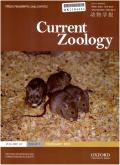Lack of response to conspecific juvenile vocalizations in two avian brood parasites
IF 2
2区 生物学
Q2 ZOOLOGY
引用次数: 0
Abstract
Juveniles of interspecific avian brood parasites need to locate and recognize conspecifics to continue their life cycle after being reared by individuals of another species. However, little is known about the recognition mechanisms and cues involved in this critical stage of their lives. It has been proposed that adult parasites could show some kind of parental behavior by actively searching and interacting with conspecific young, which in turn could serve the juveniles to learn and/or reinforce the learning of conspecific characteristics. Since acoustic communication is one of the main channels used by birds, if such form of parental behavior by adult avian brood parasites does exist, adult cowbirds should recognize and respond positively to vocalizations of conspecific juveniles. We experimentally tested whether adult shiny Molothrus bonariensis and screaming M. rufoaxillaris cowbirds respond positively towards acoustic signals of conspecific juveniles using two playback experiments, one conducted in semi-captivity and the other in the field. In both cases, we presented three types of playbacks to adults of both cowbird species: vocalizations of shiny cowbird juveniles, vocalizations of screaming cowbird juveniles, and white noise as a control. In the experiment in semi-captivity, no significant differences were found between treatments. In the field experiment, no conspecifics approached the playback area, but hosts of the species whose playback was played were attracted to the loudspeaker. In conclusion, our results do not support the predictions we tested from the parental behavior hypothesis and indicate that adult shiny and screaming cowbirds do not respond positively to acoustic signals of conspecific juveniles, at least not to the type of signals used in our experiments.两种鸟类寄生虫对同种幼鸟鸣叫缺乏反应
鸟类种间寄生物幼体在被其他物种的个体饲养后,需要定位和识别同种寄生物以继续其生命周期。然而,人们对他们生命中这个关键阶段的识别机制和线索知之甚少。研究认为,成虫可能通过主动寻找同种幼体并与之互动而表现出某种亲代行为,从而为幼虫学习和/或加强对同种特征的学习提供服务。由于声音通信是鸟类的主要通信渠道之一,如果成年鸟的这种亲代行为确实存在,成年牛鹂应该识别并积极响应同种幼鸟的发声。本文采用半圈养和野外两种回放实验的方法,研究了发光牛尾鸲和尖叫牛尾鸲成年鸟对同种幼鸟的声音信号是否有积极的反应。在这两种情况下,我们向两种牛仔鸟的成年鸟提供了三种类型的回放:闪亮的牛仔鸟幼鸟的发声,尖叫的牛仔鸟幼鸟的发声,以及作为对照的白噪音。在半圈养实验中,处理之间没有发现显著差异。在野外实验中,没有同种昆虫接近播放区域,但播放播放的物种的宿主被扬声器吸引。总之,我们的结果不支持我们从亲代行为假说中测试的预测,并且表明成年闪亮和尖叫的牛鹂对同种幼鸟的声音信号没有积极的反应,至少不是对我们实验中使用的信号类型。
本文章由计算机程序翻译,如有差异,请以英文原文为准。
求助全文
约1分钟内获得全文
求助全文
来源期刊

Current Zoology
Agricultural and Biological Sciences-Animal Science and Zoology
CiteScore
3.20
自引率
9.10%
发文量
111
审稿时长
6 weeks
期刊介绍:
About the Journal
Current Zoology (formerly Acta Zoologica Sinica, founded in 1935) is an open access, bimonthly, peer-reviewed international journal of zoology. It publishes review articles and research papers in the fields of ecology, evolution and behaviour.
Current Zoology is sponsored by Institute of Zoology, Chinese Academy of Sciences, along with the China Zoological Society.
 求助内容:
求助内容: 应助结果提醒方式:
应助结果提醒方式:


